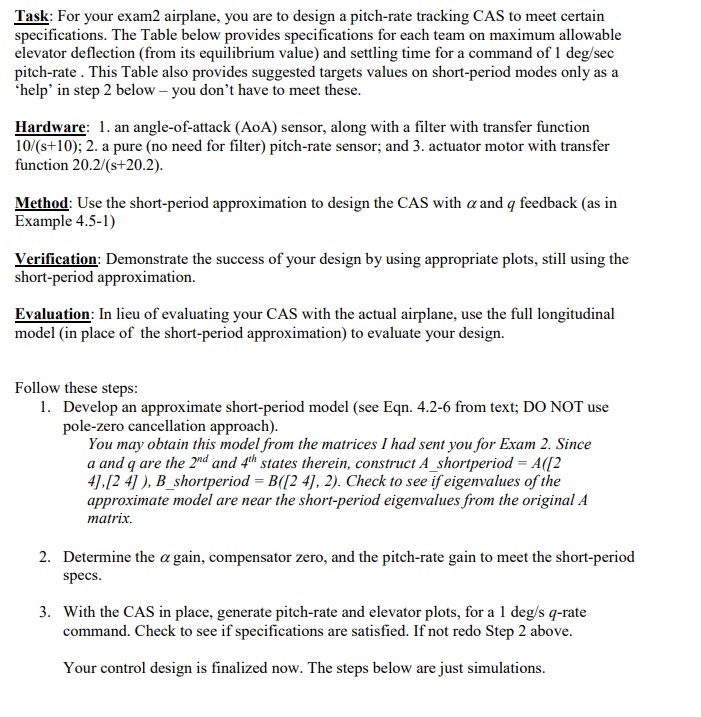Answered step by step
Verified Expert Solution
Question
1 Approved Answer
The Short-Period Approximation The short-period approximation obtained from (4.2-5) is [VTe Zi 0 -M Za VTe+Zq Zse (4.2-6) + Mse = Ma Ma where,






The Short-Period Approximation The short-period approximation obtained from (4.2-5) is [VTe Zi 0 -M Za VTe+Zq Zse (4.2-6) + Mse = Ma Ma where, for compactness, M will be assumed to include Mr. The transfer function matrix is given by C(SE-A)-B= (s-Ma) Zse+(VT +ZqMse - sp [(SM+Ma)Zse + [s(VT Z) Za]Me where C is the appropriate coupling matrix for a or q and Asp is the short-period characteristic polynomial: Asp = (VT-Za)s - [Za + (Vr Z)Mq + (Vr+Zq)M]s +MqZa - (VT+Zq)Ma (4.2-7) Task: For your exam2 airplane, you are to design a pitch-rate tracking CAS to meet certain specifications. The Table below provides specifications for each team on maximum allowable elevator deflection (from its equilibrium value) and settling time for a command of 1 deg/sec pitch-rate. This Table also provides suggested targets values on short-period modes only as a 'help' in step 2 below - you don't have to meet these. Hardware: 1. an angle-of-attack (AOA) sensor, along with a filter with transfer function 10/(s+10); 2. a pure (no need for filter) pitch-rate sensor; and 3. actuator motor with transfer function 20.2/(s+20.2). Method: Use the short-period approximation to design the CAS with a and q feedback (as in Example 4.5-1) Verification: Demonstrate the success of your design by using appropriate plots, still using the short-period approximation. Evaluation: In lieu of evaluating your CAS with the actual airplane, use the full longitudinal model (in place of the short-period approximation) to evaluate your design. Follow these steps: 1. Develop an approximate short-period model (see Eqn. 4.2-6 from text; DO NOT use pole-zero cancellation approach). You may obtain this model from the matrices I had sent you for Exam 2. Since a and q are the 2nd and 4th states therein, construct A_shortperiod = A([2 4],[24]), B_shortperiod = B([24], 2). Check to see if eigenvalues of the approximate model are near the short-period eigenvalues from the original A matrix. 2. Determine the a gain, compensator zero, and the pitch-rate gain to meet the short-period specs. 3. With the CAS in place, generate pitch-rate and elevator plots, for a 1 deg/s q-rate command. Check to see if specifications are satisfied. If not redo Step 2 above. Your control design is finalized now. The steps below are just simulations. specification suggested values max short- shot-period settling elevator (deg) period damped freq time (sec) damping (rad/s) 2.00 5.00 0.70 6.00 4. Repeat Step 3 above with the approximate model replaced by the full linearized longitudinal model. You will now have four airplane states. Plot all the airplane states and elevator movement. Make appropriate observation.
Step by Step Solution
There are 3 Steps involved in it
Step: 1

Get Instant Access to Expert-Tailored Solutions
See step-by-step solutions with expert insights and AI powered tools for academic success
Step: 2

Step: 3

Ace Your Homework with AI
Get the answers you need in no time with our AI-driven, step-by-step assistance
Get Started


